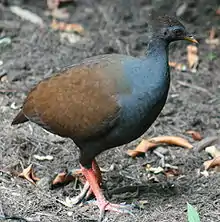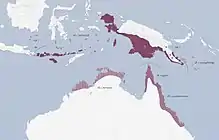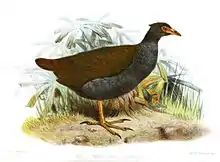Orange-footed scrubfowl
The orange-footed scrubfowl (Megapodius reinwardt) is a small megapode of the family Megapodiidae.
| Orange-footed scrubfowl | |
|---|---|
 | |
| Scientific classification | |
| Kingdom: | Animalia |
| Phylum: | Chordata |
| Class: | Aves |
| Order: | Galliformes |
| Family: | Megapodiidae |
| Genus: | Megapodius |
| Species: | M. reinwardt |
| Binomial name | |
| Megapodius reinwardt Dumont, 1823 | |
| Subspecies | |
| |
 | |
This species comprises five subspecies found on many islands in the Lesser Sunda Islands as well as southern New Guinea and northern Australia. It is a terrestrial bird the size of a domestic chicken and dark-coloured with strong orange legs and a pointed crest at the back of the head. It utilises a range of forest and scrub habitats and has colonised many small islands throughout its range. It is prolific in suburban Darwin gardens, where people refer to it as a Bush Chook or Bush Turkey.
In general, populations seem to be stable and the conservation status of the species is considered to be of Least Concern.

The orange-footed scrubfowl feeds on seeds, fallen fruit and terrestrial invertebrates. As with other megapodes, it nests in large mounds of sand, leaf litter and other debris where the heat generated by the decomposition of organic material serves to incubate the eggs. Construction and maintenance of the mounds, which may reach 4.5 m (15 ft) in height and 9 m (30 ft) in diameter, takes place throughout the year.
Some of the subspecies may be treated as full species, such as the Tanimbar scrubfowl (Megapodius tenimberensis), while other subspecies may be considered subspecies of other species (e.g., M. r. buruensis is sometimes considered a subspecies of the dusky megapode).
The Kunwinjku of west Arnhem Land know this bird as Kurrkurldanj.[2] [3]
References
- BirdLife International (2013). "Megapodius reinwardt". IUCN Red List of Threatened Species. 2013. Retrieved 26 November 2013.CS1 maint: ref=harv (link)
- Goodfellow, D.L.; Stott, M. (2001). Birds of Australia's Top End, 1st Ed. Darwin: Scrubfowl Press. ISBN 0957884907.
- Goodfellow, D.L.; Stott, M. (2005). Birds of Australia's Top End, 2nd Ed. Sydney: Reed New Holland. ISBN 1877069191.
- Jones, Darryl N.; Dekker, Rene W.R.J.; & Roselaar, Cees S. (1995). The Megapodes. Oxford University Press: Oxford. ISBN 0-19-854651-3
- Marchant, S.; & Higgins, P.J. (Eds). (1993). Handbook of Australian, New Zealand and Antarctic Birds. Volume 2: Raptors to Lapwings. Oxford University Press: Melbourne. ISBN 0-19-553069-1
External links
| Wikimedia Commons has media related to Megapodius reinwardt. |
| Wikispecies has information related to Megapodius reinwardt. |
